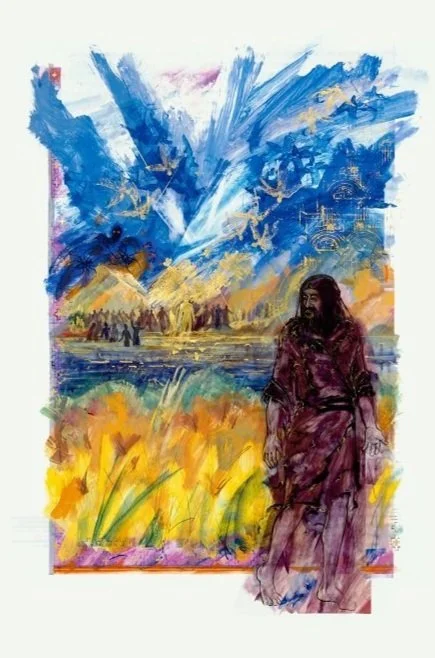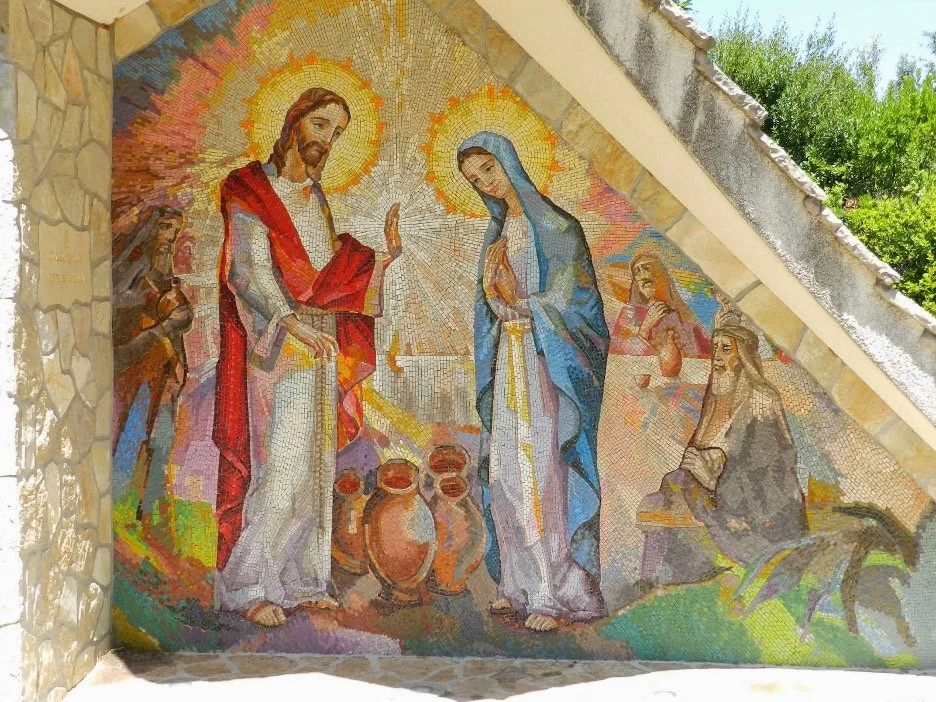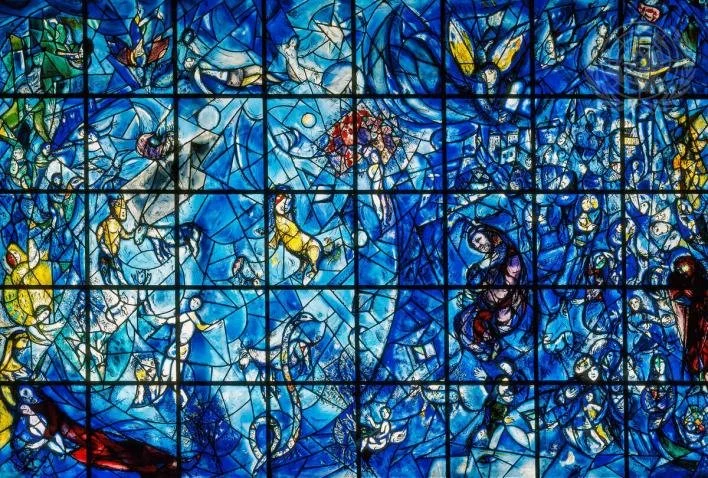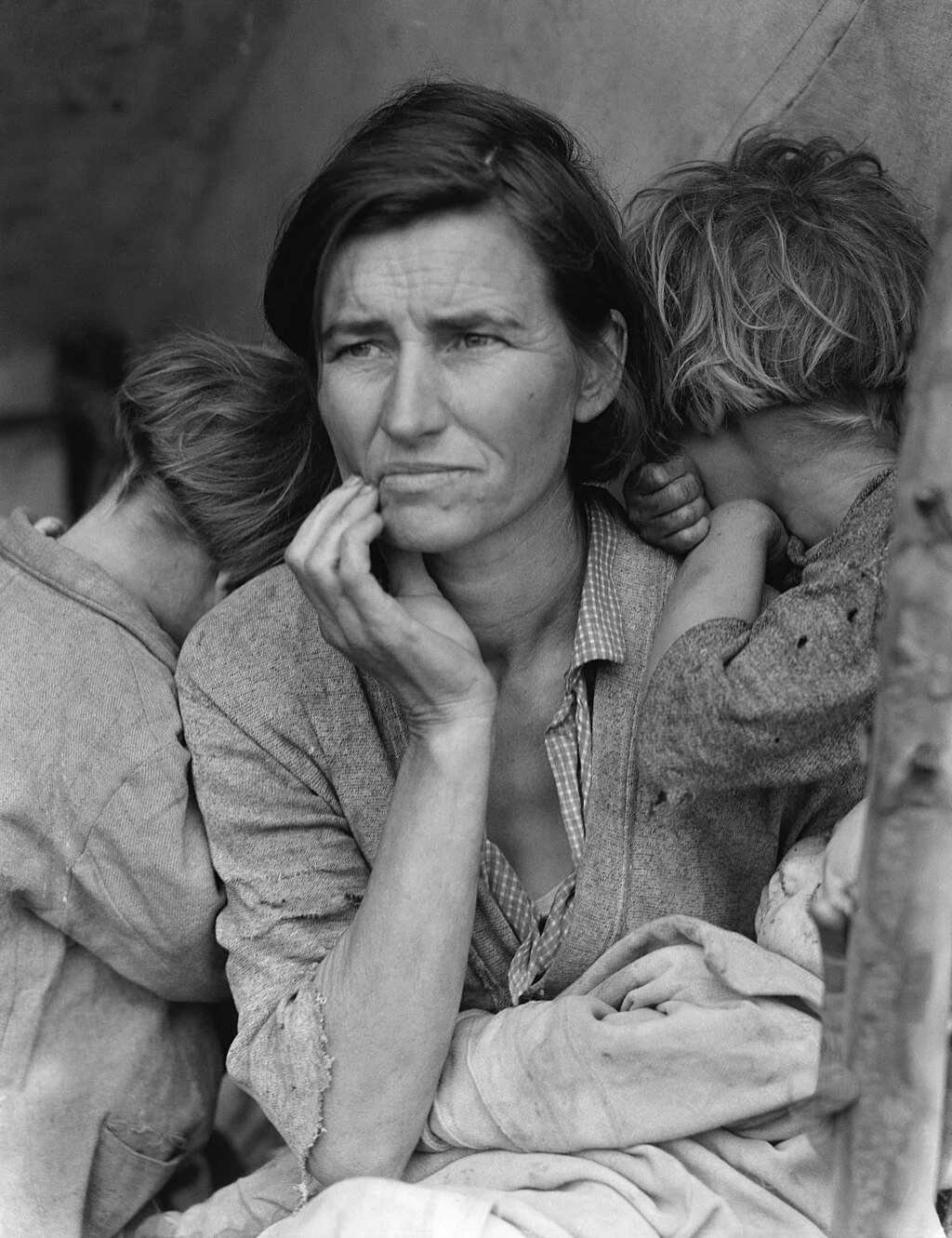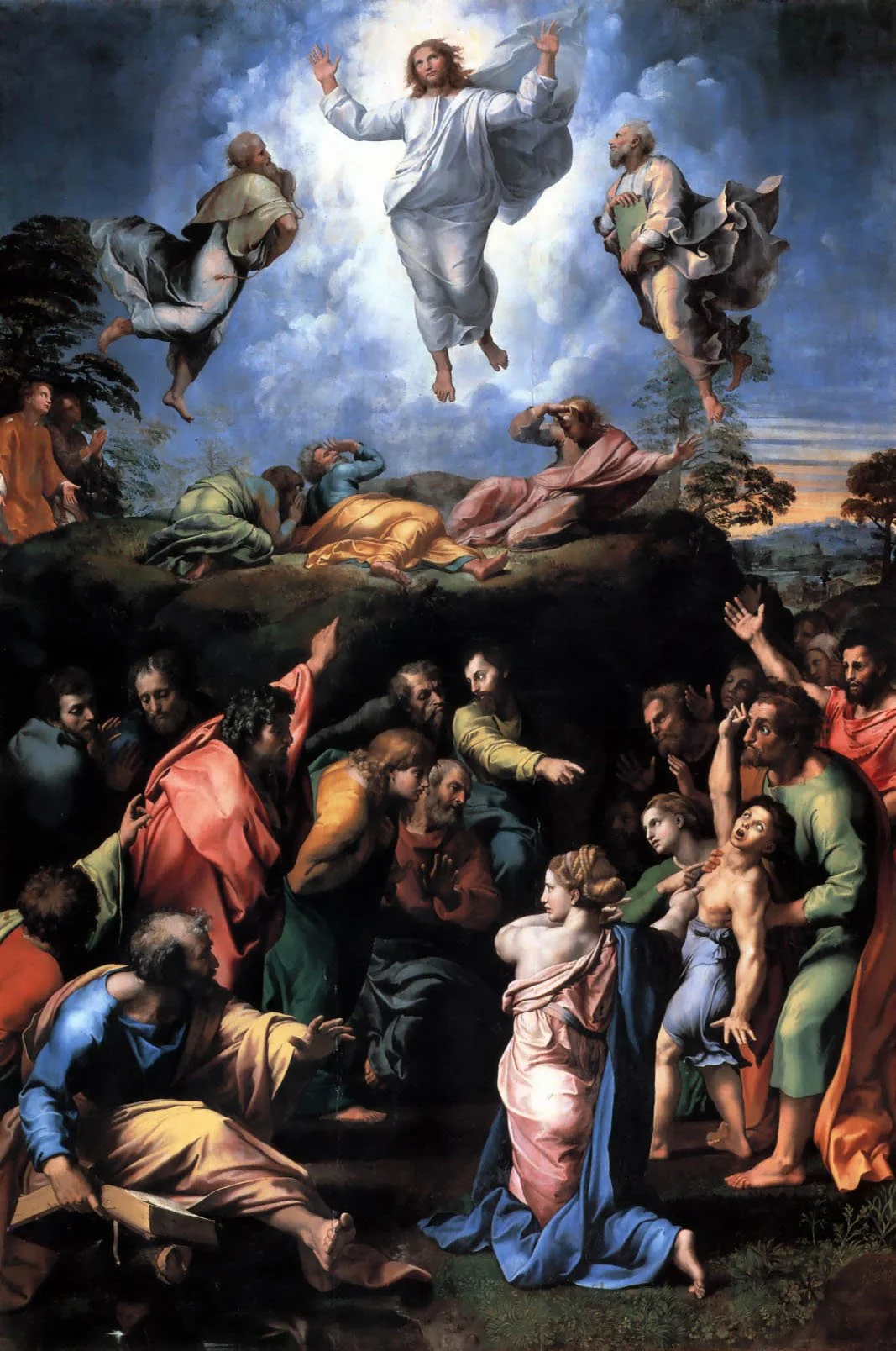Visio Divina
Over the next few weeks, we will be practicing Visio Divina as part of our Sunday Morning Reflection Group at 9 a.m. You can join us in person or practice from home. Learn how below.
An illumination featured in The Saint John's Bible.
Visio Divina is an ancient spiritual practice that invites us into a “divine seeing.” Visio divina shares roots with the ancient practice of lectio divina. (Lectio divina calls for a slow, careful interaction with scripture through meditation and prayer, allowing a word or phrase to rise in our consciousness, a holy word to savor and examine.) Similarly, visio divina invites us to encounter the divine through images. A prayerful consideration of and interaction with a photograph, an icon, a piece of art, or other visual representation allows the viewers to experience the divine in a unique and powerful way.
You may practice visio divina individually or in a small group or worship setting by using a piece of art as a focal point for prayer. You can also pair scripture with the image in order to reflect on the scripture through the art.
Try It Out
1. Pick out an image: a photograph, painting, or icon.
2. Look at the image and let your eyes stay with one part of the image that draws you in or intrigues you. Perhaps focus your attention on the part of the image that first catches your eye. Try to keep your eyes from wandering to other parts of the picture. Breathe deeply and let yourself gaze at that part of the image for a minute or so. How is God speaking to you? Is there a message or memory that it brings up?
3. Now let your eyes gaze at the whole image. Take your time and look at every part of the photograph. See it all, the background, the foreground, the details. Reflect on the image for a minute or so.
4. Consider the following questions:
What emotions does this image evoke in you?
What does the image stir up in you, bring forth in you?
Is there an invitation for you in the image?
Is there a Scripture passage that comes to mind? Perhaps read the passage as part of your meditation.
Does this image lead you into an attitude of prayer? If so, let these prayers take form in you. Write them down if you desire.
5. Offer your prayers to God now in a final time of silence.
Week 1: The Epiphany
Gentile da Fabriano, Adoration of the Magi, 1423, tempera on panel, 283 x 300 cm (Uffizi Gallery, Florence) (photo: Steven Zucker, CC BY-NC-SA 4.0)
Kathy Stockman notes: “There is much happening in this painting. The artist uses the continuous narrative method of presenting the story. Notice the image of the Magi is repeated to indicate the seeing of the star, the travel, and finally the arrival and visit to see the Christ child. A number of Early Renaissance artists used this method to present Bible stories. The details in the painting are incredibly elaborate. Notice the brilliant colors, various fabrics, people, and even animals that we don’t usually associate with a Nativity scene.”
What do you see?
Week 2: The Baptism of Jesus
This piece of art is a depiction of John the Baptism and is a part of the Saint John’s Bible.
Donald Jackson, Baptism of Jesus, St. John’s Bible
In 1998, the Benedictine monks of St. John's Abbey in Minnesota commissioned renowned calligrapher Donald Jackson, the official scribe to Queen Elizabeth II, to create a hand-written, hand-illuminated Bible to celebrate a new millennium. The work took thirteen years to complete. With a team of 15 scribes and illuminators located on two continents, Jackson has created a Bible for the modern world.
The purpose of The Saint John's Bible is the following: "At the onset of a new millennium, Saint John's University and the monks of Saint John's Abbey sought to ignite the spiritual imagination of people throughout the world by commissioning a work of art that illuminates the world today." Donald Jackson and his team also outlined during the production of the Bible six core values for its readers to apply to their lives: igniting spiritual imagination, glorifying God's word, reviving tradition, discovering history through manuscript exploration, fostering the arts, and giving a voice to the underprivileged. You can find more info here. How can art reveal the word of God to us?
Week 3: The Wedding at Cana
Ariggo Paz, Luminous Mystery Mosaic, the Wedding at Cana in Medjugorje
In 1981, six Croatian youths in the village of Medjugorje, Bosnia-Hercegovina, began to see the visions of the Virgin Mary and receive messages from her. For millions of people all over the world these extraordinary events, together with the heavenly instructions, have become a source of renewal within their Christian lives. Our Lady has regularly appeared in Medjugorje since 1981, and the countless stories of conversion, healing and miracles, makes the story of Medjugorje one of the most fascinating in modern church history.
The Luminous Mysteries, also known as the Mysteries of Light, show how Jesus manifested God's light. Pope John Paul II established the Luminous Mysteries in 2002 in his apostolic letter Rosarium Virginis Mariae. Just behind the parish of St. James in Medjugorje is a beautiful tree-lined path lined with five stunning mosaics that depict the Luminous Mysteries of the Rosary. Pilgrims often walk the Via Domini, contemplating the public life and ministry of Jesus as they pray.
Week 4: Jesus in the Synagogue
The Peace Window is a memorial in stained-glass is a tribute to the late Secretary-General Dag Hammarskjöld (1905 – 1961), and the 15 UN staff members and UN peacekeepers who died with him. Their plane crashed while flying to a peace negotiation for the Congo Crisis in Northern Rhodesia. It was given in 1964 was one of Chagall’s largest and most ambitious projects and was inspired by Isaiah 9:1-7. It is is located in the public lobby of the United Nations Secretariat Building in New York City. The window if full of religious symbolism as was much of Chagall’s work. Chagall was a painter and printmaker and only late in life started making stained glass.
“The Peace Window is deeply informed by the largeness of Chagall’s vision: by his compassion and tolerance and, as a Jewish artist who lived in exile from a beloved homeland for most of his adult life and witnessed both world wars, by his deep understanding of human suffering. He elevates the symbolic language of one specific spiritual tradition to the level of universal meaning, making it something to which all people can relate.” More about the window can be found here.
We can reflect on Jesus reading from the scroll of Isaiah in the synagogue proclaiming the "The Spirit of the Lord is upon me, because he has anointed me to bring good news to the poor. He has sent me to proclaim release to the captives and recovery of sight to the blind, to let the oppressed go free, to proclaim the year of the Lord's favor." How do we bring about this kind of Jubilee in our time?
Week 5: Fishing Nets
To create Spiral for Shared Dreams, Columbian artist Carolina Caycedo collaborated with four fishing collectives from Mexico that wove the 11 handmade atarrayas, or fishing nets, that comprise this installation. Natural and mythological figures appear on some of the nets pointing to the sacred work of fishing and the natural world.
How can art create a sacred space and draw our attention to environmental threats? Caycedo interviewed and explored the impact of environmental challenges for the collectives. Each of the communities are especially impacted by hydroelectric dams or other changes to bodies of water.
In an interview she notes, “When you examine it, the fishing net is the opposite of an infrastructural construction, such as a dam. The dam is this impermeable, monumental, gargantuan, corporate, industrial design that stops the flow of water and cuts the body of a river in two. On the other hand, a handmade fishing net exists on a human scale. It’s porous, flexible, malleable, and captures sustenance while letting water through. It breaks with use but can be repaired. And even if one of the knots is untied, it doesn’t compromise the function of the whole structure.”
Can we see sacred art in everyday objects and reflect on our impact on the world around us? How might we live in harmony with nature? Our Scripture passage is Luke 5: 1-11. We are called to follow Jesus who used the everyday work and metaphors of the people of his time to show what God can do in our lives.
Week 6: The Beatitudes
Haywood Street Beatitudes Fresco by Christopher Holt
The Haywood Street Beatitudes fresco was completed in 2019 in the sanctuary of Haywood Street Congregation in Asheville, part of whose mission is “breaking down barriers that divide the ‘haves’ from the ‘have-nots’ and reminding each person of their worth, their goodness.”
The fresco is the result of a two-year community project led by Christopher Holt with the Rev. Brian Combs, founder of the Haywood Street congregation in Asheville. The purpose of the Haywood Street fresco is to honor everyday people and emphasize the church’s ministry, which focuses on helping members of the community who live in poverty and often on the margins of society.
The Haywood Street Beatitudes contains a more racially and socioeconomically diverse set of individuals that is reflective of the makeup of the community. Its message is that “God continues to show up in everyday life among the unhoused and the housed, the poor and poor in spirit, the meek, the merciful, and the hungry.”
Here is a short video about the project. You can also watch a longer documentary on Amazon Prime called Theirs is the Kingdom. Devin and some of our youth got to visit Haywood Street and see this fresco and help out with a community meal two years ago on our summer mission trip.
Week 7: Love and Mercy
Migrant Mother by Dorthea Lange
Documentary photographer Dorothea Lange had a favorite saying: "A camera is a tool for learning how to see without a camera." Lange revealed the human toll of the Great Depression.
o one did more to reveal the human toll of the Great Depression than Lange. Her photographs gave us an unflinching — but also deeply humanizing — look at the struggles of displaced farmers, migrant laborers, sharecroppers and others at the bottom of the American farm economy as it reeled through the 1930s.
Dorthea Lange’s most famous photo is this one, often referred to as "Migrant Mother." Shot in 1936 at a campsite full of unemployed pea pickers in Nipomo, California, the image features Florence Owen Thompson, a poor farmworker flanked by two of her seven children, while a third, a baby wrapped in burlap, rests on her lap. Freezing rain had destroyed the pea crop. Thompson and her kids "had been living on frozen vegetables from the surrounding fields, and birds that the children killed," Lange wrote in her notes. "She had just sold the tires from her car to buy food." But you don't need to read Lange's notes to sense this desperation. So much is conveyed in the worry etched on Thompson's face, worn far beyond her 32 years at the time the photo was taken.
Lange understood that photographs can speak a powerful visual language of their own. As she once said: "No country has ever closely scrutinized itself visually ... I know what we could make of it if people only thought we could dare look at ourselves." Her work provided a stark, humanizing look at the effects of the Great Depression, bringing attention to the plight of the poor and influencing public perception and policy.
Jesus calls us in this week’s gospel to “Love your enemies, do good to those who hate you, bless those who curse you, pray for those who abuse you. If anyone strikes you on the cheek, offer the other also; and from anyone who takes away your coat do not withhold even your shirt. Give to everyone who begs from you; and if anyone takes away your goods, do not ask for them again. Do to others as you would have them do to you.”
How might we be inspired to respond to Jesus’ command by really looking into the faces of those in need in our world? How does art inspire us to respond with mercy and love?
Week 8: The Transfiguration
The Transfiguration, Raphael
This is the last painting by the Italian Renaissance master Raffaello Sanzo da Urbino (better known as simply “Raphael”). Cardinal Giulio de Medici (future Pope Clement VII) commissioned the work, conceived as an altarpiece for Narbonne Cathedral in France.
Raphael worked on it in the years preceding his death in 1520. The painting exemplifies Raphael's development as an artist and the culmination of his career. The work is now in the Vatican Museum. From the late 16th century until the early 20th century, various commentators regarded it as the most famous oil painting in the world.
The altarpiece illustrates two episodes narrated in succession in the Gospel according to Matthew: the Transfiguration above, with Christ in glory between the prophets Moses and Elijah, and below, in the foreground, the meeting of the Apostles with the obsessed youth who will be miraculously cured by Christ on his return from Mount Tabor.
How are you changed by seeing Christ transfigured?



